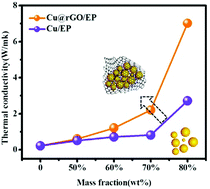Core–shell Cu@rGO hybrids filled in epoxy composites with high thermal conduction†
Abstract
Due to the increased power density of electronic devices, the heat originated from the core components increases the working temperature of the devices, enormously degrading their reliability and shortening their lifespan. So, effective heat dissipation from high-power electronic devices has become an urgent and complex problem. Herein, we report epoxy-based composites with an enhanced thermal conductivity by using reduced graphene oxide encapsulated copper sphere (Cu@rGO) hybrids as fillers. The Cu@rGO hybrid exhibits a 3D structure with high oxidation resistance. The obtained polymer composites exhibit a high thermal conductivity (7 W m−1 K−1), as the loading of the Cu@rGO hybrids is 80 wt%, which is 2.6 times higher than that of the polymer composites filled with only Cu spheres. The high thermal conductivity might be attributed to the synergistic effects between spherical Cu and rGO nano-sheets, which enhanced the oxidation resistance of copper and increased the thermal transfer path, along with the reduced interfacial thermal resistance between Cu and epoxy resins. In addition, the Cu@rGO/epoxy composites reveal a decreased thermal expansion coefficient (CTE), an increased glass transition temperature (Tg), and an enhanced shear strength. This unique 3D core–shell Cu@rGO structure and its epoxy composites with high thermal conductivity and dimensional stability could be suitable as excellent thermal interface materials in advanced electronic packaging techniques.

- This article is part of the themed collection: Materials and Nano Research in Atlanta


 Please wait while we load your content...
Please wait while we load your content...